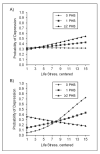"White Box" Epidemiology and the Social Neuroscience of Health Behaviors: The Environmental Affordances Model
- PMID: 24224131
- PMCID: PMC3820104
- DOI: 10.1177/2156869313480892
"White Box" Epidemiology and the Social Neuroscience of Health Behaviors: The Environmental Affordances Model
Abstract
Crucial advances have been made in our knowledge of the social determinants of health and health behaviors. Existing research on health disparities, however, generally fails to address a known paradox in the literature: While blacks have higher risk of medical morbidity relative to non-Hispanic whites, blacks have lower rates of common stress-related forms of psychopathology such as major depression and anxiety disorders. In this article we propose a new theoretical approach, the Environmental Affordances Model, as an integrative framework for the origins of both physical and mental health disparities. We highlight early empirical support and a growing body of experimental animal and human research on self-regulatory health behaviors and stress coping that is consistent with the proposed framework. We conclude that transdisciplinary approaches, such as the Environmental Affordances Model, are needed to understand the origins of group-based disparities to implement effective solutions to racial and ethnic group inequalities in physical and mental health.
Keywords: allostatic load; mental health; race/ethnicity; stress-buffering effects.
Figures



References
-
- Adam Tanja C, Epel Elissa S. Stress, Eating and the Reward System. Physiology and Behavior. 2007;91:449–58. - PubMed
-
- Aneshensel Carol. Depression, Alcohol Use, and Smoking over One Year: A Four-wave Longitudinal Causal Model. Journal of Abnormal Psychology. 1983;92:134–50. - PubMed
-
- Armario Antonio. Activation of the Hypothalamic-pituitary-adrenal Axis by Addictive Drugs: Different Pathways, Common Outcome. Trends in Pharmacological Sciences. 2010;31:318–25. - PubMed
-
- Benton Tami, Staab Jeffrey, Evans Dwight L. Medical Comorbidity in Depressive Disorders. Annals of Clinical Psychiatry. 2007;19:289–303. - PubMed
Grants and funding
LinkOut - more resources
Full Text Sources
Other Literature Sources
